Lateral Office (Toronto) + Paisajes Emergentes (Medellín)
Designed for Site #2 in Abu Dhabi, between Saadiyat Island and Yas Island.
Lateral Office: Mason White, Lola Sheppard, Matthew Spremulli, and Fei-Ling Tseng
Paisajes Emergentes: Luis Callejas, Sebastián Mejia, Edgar mazo, Alexander Laing
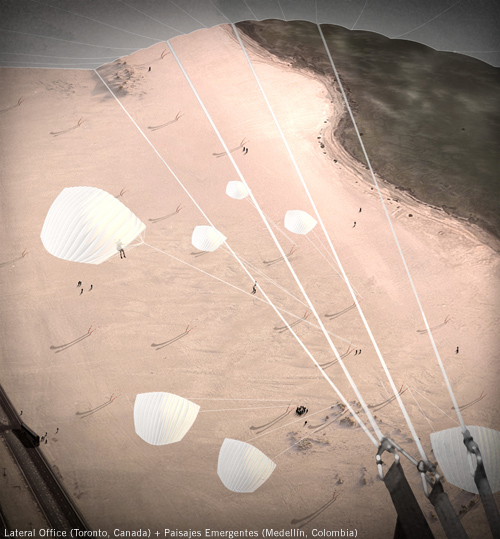
Design Submission for the 2010 Land Art Generator Initiative Design Competition
Artist’s descriptive text:
LAGI: WeatherField
WeatherField is a shape-shifting energy generation park along a strip of sandy beach in Abu Dhabi between Yas and Saadiyat Islands. The park is an open public space and is capable of harvesting the abundant renewable energy resource of wind within the Middle East context. The public park offers a variety of ways to engage with climate and renewable energy, as an economic sponsor, as a visual or physical experience, and as information.
Unlike current renewable energy fields where technologies are publicly inaccessible, static, and always on, WeatherField offers a range of public engagement dependent upon wind, sun, and moisture. Energy generation becomes a public performance, dynamic, reactive, and interactive. The park is active when weather events are active, and calm when weather is calm, in each instance offering the public compatible experiences.
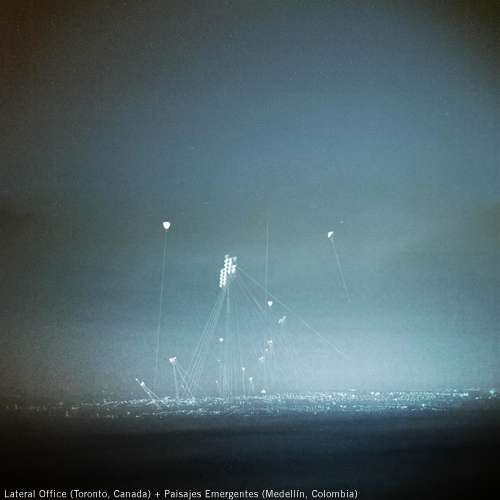
A. What is a 21st Century Energy Landscape?
Weather = Energy
The park is organized and designed to respond efficiently and creatively to climate. The intention is that the park serve as a barometer of regional weather events. WeatherField is simultaneously a public space, a dynamic energy icon, and a public weather service. The field is a registration of daily weather events including weather events such as Shamals winds, dense fog, and sandstorms, among others.
The Yas Island energy park is comprised of a field of 200 “Para-kites,” each is equipped with a base station of two flexible posts. Except for the posts that tether the para-kites, the ground and aquatic ecology is undisturbed. The para-kites use a parafoil system to remain aloft and a Windbelt™ system to harvest “flutter” energy from the wind.
At the Yas Island test site, the 200 para-kites extend across the site in a 60 meter grid that marks the tide levels. Each para-kite is capable of 6,220 kwh annually. Preliminary calculations generate approximately 21.6 kwh/month for each cell of the para-kite. With 24 cells per para-kite, that yields 518.4 kwh/month for each para-kite. Across the WeatherField, we calculate 1.24 GW annually, or about 620 energy-efficient homes. Or, more colloquially, each para-kite is able to power three homes for a year.
Experience and Economics
WeatherField patterns form in response to maximize performance in various weather events. These geometries are artful, as in sky-writing kite festivals, but also efficient and engineered.
WeatherField offers three kinds of public experience:
1) From a residential home, a sponsoring resident may have free electricity and a free view of the Gulf.
2) On the park’s site, a visitor may have the view using an embedded ‘periscope’ in each post.
3) An adventurous visitor may be harnessed to a para-kite to witness the view first-hand.
As a park, visitors or residents can witness and experience their commitment to renewable energy field in many different ways. They can be stake holders, investing in a single generator para-kite. The investor receives energy equivalent to that harvested by that generator, as well as a live feed view of the landscape from the para-kite into their home. This in house artwork serves a weather gauge and a ‘living’ landscape painting. Visitors to the energy park can also approach the support posts and have a ‘periscope’ view from the ground of the para-kite’s view. And finally, a visitor, may elect—with managed permission—to ride up in a para-kite. This allows the economic models for the implementation of the project to be distributed either before, through residential stakeholders, or after capital costs, through tourism. The project has an entrepreneurial spirit.
The park generates other phenomenal events such as playful shadows on the ground and dynamic patterns in the sky. These geometries could be commissioned to environmental artists, or could be coordinated with regional events or seasonal holidays.
Unlike large-scale energy infrastructures that are out-of-scale, off-site, and off-limits, WeatherField is interactive, and its energy capacity is scalable to the size of a single-home. In other words, energy use is quantifiable and qualitative at the scale of a single user, promoting energy efficiency and energy consciousness.
B. How does it work?
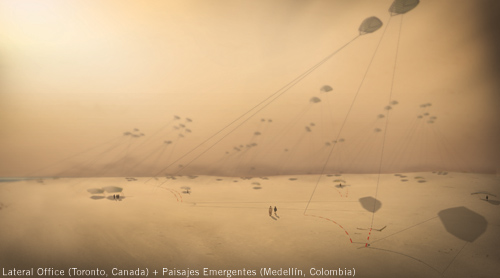
The Para-kite
The para-kite is a hybrid of a parachute, a kite, and a glider. It is equipped with a series of hollow air chamber cells along its length, which allows it to become airborne and remain aloft in sufficient winds. As wind passes through the air cells, it encounters a series of non-turbine energy harvesting Windbelts™ along the depth of the chamber. The belts thin profile converts “aerolastic flutter” to AC power within the para-kite’s chambers. Only low to medium air movement is necessary for this technology to still have significant impact. The Windbelt™ generates AC power down the suspension lines to the supports posts. From there, electricity is carried in series to a step-up transmission station on site, before being fed into the high voltage power grid to the southeast.
The side trim of the para-kites is equipped with light-weight magnetic strips. Para-kites can be aggregated and clustered to maximize a response to each weather condition. For example, during the Shamals wind, which can last up to 5 days continuously during the summer months, the para-kites gather in clusters of 5-6 in order to maximize harvest.
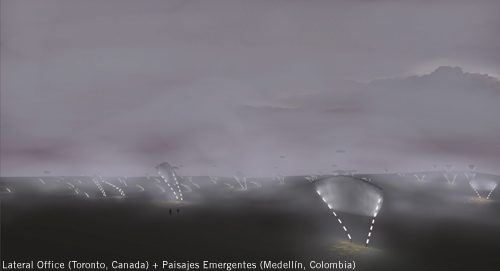
The Para-kite has a base station that consists of two carbon fiber posts. These are used for alternate positions such as fog, low wind conditions, and preparation for tourist riders, but it is also convenient for maintenance, storage, and as a sun shade.
WeatherFields Regional Network
WeatherField is a catalyst for a regional energy plan in the Middle East. The WeatherField at Yas Island is the initial phase development to spawn a large-scale re-consideration of energy in the Gulf region. With such an abundance of wind, there is considerable potential for the Gulf to be the largest renewable energy field in the world and a model for future regional planning.
Just as oil and gas operations have sought out invisible subterranean (geological) conditions for the harvest of dirty energy, the Weather Fields will seek out meteorological conditions for the harvest of clean energy. In order to symbolically transition from an oil-dependent energy state to a weather-dependent energy state, WeatherFields co-opt existing oil / gas field sites.
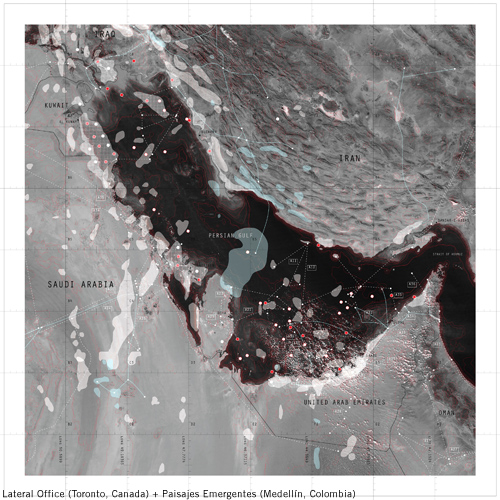
The regional plan proposes the decommissioning of a 20th century industrial energy fields across the Persian Gulf and its transformation into a network of 21st century public energy parks.
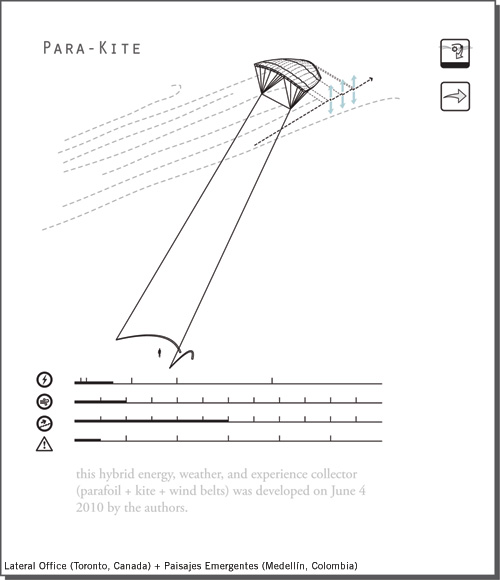
Related Posts
3 Comments
Add comment Cancel reply
This site uses Akismet to reduce spam. Learn how your comment data is processed.

[…] further afield. One of the most striking entries to appear on the competition blog so far is the Weather Field, by Lateral Office and Paisajes Emergentes. The design draws on the wind power available in the […]
[…] further afield. One of the most striking entries to appear on the competition blog so far is the Weather Field, by Lateral Office and Paisajes Emergentes. The design draws on the wind power available in the […]
[…] further afield. One of the most striking entries to appear on the competition blog so far is the Weather Field, by Lateral Office and Paisajes Emergentes. The design draws on the wind power available in the […]